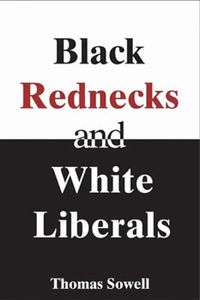Black Rednecks and White Liberals
Black Rednecks and White Liberals is a collection of six essays by Thomas Sowell. The collection, published in 2005, explores various aspects of race and culture, both in the United States and abroad. The first essay, the book's namesake, traces the origins of the "Ghetto" African American culture to the culture of Scotch-Irish Americans in the Antebellum South. The second essay, "Are Jews Generic?", discusses middleman minorities; while "The Real History of Slavery" discusses the timeline of abolition of slavery and serfdom. The last three essays discuss the history of Germany, African-American education, and criticism of multiculturalism.
 Hardcover edition | |
| Author | Thomas Sowell |
|---|---|
| Subjects | African American culture, Multiculturalism |
| Publisher | Encounter Books |
Publication date | June 25, 2005 |
| Media type | Print (Hardcover and Paperback) |
| Pages | 360 pp. |
| ISBN | 978-1-59403-086-4 |
| OCLC | 57579375 |
Essays
Black Rednecks and White Liberals
The title essay states Sowell's thesis about the origins of the "black ghetto" culture.
Sowell argues that the black ghetto culture originates in the dysfunctional white southern redneck culture which was prominent in the antebellum South. This culture came, in turn, from the "Cracker culture" of "North Britons", that is, border English, highland Scots, Welsh, and Ulstermen who emigrated from the more lawless border regions of Britain in the eighteenth century.[1]
Are Jews Generic?
In the collection's second essay, Sowell explores the origins of antisemitism among those harboring jealousy toward Jews for their financial and entrepreneurial successes.
Among other historically persecuted "middlemen minorities" were Lebanese and Chinese immigrant merchants. The resentment is due to a perceived "lack of added value" that these middlemen provide, as it is not easily observable.
The Real History of Slavery
In the collection's third essay, Sowell reviews the history of slavery. Contrary to popular impression, which blames Western society and white people as the culprits, Sowell argues that slavery was a universal institution accepted and embraced by nearly all human societies. The world's trade in slaves, then slavery itself, was forcibly abolished by the British in the nineteenth century, against opposition in Africa and Asia where it was considered normal. The economic effects of slavery are also misunderstood, since slaves were often a luxury item whose upkeep was a drain on the rich, and nowhere did the availability of cheap slave labour result in wealthy societies.
Germans and History
The fourth essay features Sowell's argument that Germany should not be defined solely by the 12-year period of Adolf Hitler's régime from 1933–45. Sowell further argues that Hitler was highly inconsistent in his views toward a unified Germany – while he strenuously argued for annexation of the German-dominated Sudetenland, German-dominated portions of Italy such as Tyrol were ignored as Hitler preferred his alliance with Benito Mussolini.
Black Education: Achievements, Myths, and Tragedies
The fifth essay features Sowell's discussion of the early days of Dunbar High School in Washington, D.C. and its eventual deterioration from its place of prominence in early Black education, which Sowell argues was a direct consequence of the famed Brown v. Board of Education United States Supreme Court decision.
Additionally Sowell argues that, though W. E. B. Du Bois was more activist in his attempts to end Jim Crow laws and other forms of legal discrimination while Booker T. Washington held a more accommodating position, Washington did at times secretly fund and support efforts to end Jim Crow laws.
History Versus Visions
The final essay features Sowell's criticism of the advantages that multiculturalism is supposed to confer to the society in which it is present.
References
- Sowell, Thomas (July 9, 2005). "Black Rednecks and White Liberals: Who's a Redneck?". Capitalism Magazine. Retrieved 2011-02-18.
External links
- Rednecks (website for book), T Sowell.